本篇随笔目录:
在关系数据库中,不同表之间往往不是全部都单独存在,而是相互存在关联的。两个不同表之间可以存在外键依赖关系,一个表自身也可以有自反关系(表中的一个字段引用主键,从而也是外键字段)。
Entity Framework Code First默认多重关系的一些约定规则:
一对多关系:两个类中分别包含一个引用和一个集合属性,也可以是一个类包含另一个类的引用属性,或一个类包含另一个类的集合属性。如在本篇接下来用到的例子Category类和Product类,要使得Category与Product之间具有一对多关系,Entity Framework Code First可以有3种体现方式:
1>、在Category类中定义ICollection<Product> Products集合属性,同时在Product类中定义Category Category引用属性。
2>、仅在Category类中定义ICollection<Product> Products集合属性。
3>、仅在Product类中定义Category Category引用属性。
多对多关系:两个类分别包含对方的一个集合属性。如在本篇接下来用到的例子User类和Role类,要使得User与Role之间具有多对多关系,即一个用户可以属于多个角色,一个角色可以有多个用户,则需要在User类中需要定义一个ICollection<Role> Roles集合属性,同时在Role类中需要定义一个ICollection<User> Users属性。
一对一关系:两个类分别包含对方的一个引用属性。如在本篇接下来用到的例子User类和UserProfile类,要使得User与UserProfile之间具有一对一关系,则需要在User类中定义一个UserProfile UserProfile的引用属性,同时在UserProfile类中定义一个User User的引用属性。
下面具体描述Entity Framework Code First生成外键的默认约定,并通过实例展示Entity Framework Code First处理一个表及多个表之间的关系。
1、外键列名默认约定
Entity Framework Code First在根据默认约定创建外键时,外键列的名称存在3种方式。在《Programming Entity Framework Code First》一书中,给出的3种外键列名的约定方式是:[Target Type Key Name], [Target Type Name] + [Target Type Key Name], or [Navigation Property Name] + [Target Type Key Name],对应的中文翻译为:[目标类型的键名],[目标类型名称]+[目标类型键名称],或[引用属性名称]+[目标类型键名称]。
Entity Framework Code First外键默认约束生成的外键在分别满足3种不同的条件下,外键列名有3种不同的命名规则。且经过测试这3种不同的外键名称命名之间存在优先级:[目标类型的键名] > [引用属性名称]+[目标类型键名称] > [目标类型名称]+[目标类型键名称]。接下来以Product类及Category类为例,分别测试外键列名称的3中不同生成方式,Category与Product为一对多关系。
1>、[目标类型的键名]
这种方式为要求在Product表中外键列名与Category表中的主键列名相同,所以也就要求在Product类中有定义与Category类中作为主键的属性。如在Category类中主键属性为CategoryID,则需要在Product类中也定义一个CategoryID的属性。
文件Category.cs:

using System; using System.Collections.Generic; using System.Linq; using System.Text; namespace Portal.Entities { public class Category { public int CategoryID { get; set; } public string CategoryName { get; set; } public virtual ICollection<Product> Products { get; set; } } }
文件Product.cs:

using System; using System.Collections.Generic; using System.Linq; using System.Text; namespace Portal.Entities { public class Product { public int ProductID { get; set; } public string ProductName { get; set; } public decimal UnitPrice { get; set; } public int CategoryID { get; set; } public virtual Category Category { get; set; } } }
说明:在Category类及Product类中的引用属性及集合属性前加virtual修饰,为的是Entity Framework Code First的延迟加载功能。不使用virtual修饰,在Category类的一个实例要查询包含的Product实例时,将不会启用延迟加载。当然Entity Framework Code First延迟加载并不是必须的,所以virtual修饰符也可以不加。
在定义以上两个类之后,不再添加任何的Entity Framework Code First与数据库的映射配置,运行之后,生成的数据表结构为:

从生成的Categories与Products表结构可以看出,在Products表中的外键CategoryID与引用的表Categories主键名称相同。跟踪Entity Framework Code First生成数据表的执行脚本可以看到具体生成外键的SQL语句。
ALTER TABLE [dbo].[Products] ADD CONSTRAINT [FK_dbo.Products_dbo.Categories_CategoryID] FOREIGN KEY ([CategoryID]) REFERENCES [dbo].[Categories] ([CategoryID]) ON DELETE CASCADE
同时,从生成外键的脚本还能看出一点,Entity Framework Code First生成外键是启用级联删除功能的。即当删除Categories表中一条记录时,数据库会自动联带删除Products表中属于该类别的记录。
在数据库中生成的Products表,查看外键FK_dbo.Products_dbo.Categories_CategoryID属性,其的确有启用级联删除功能。
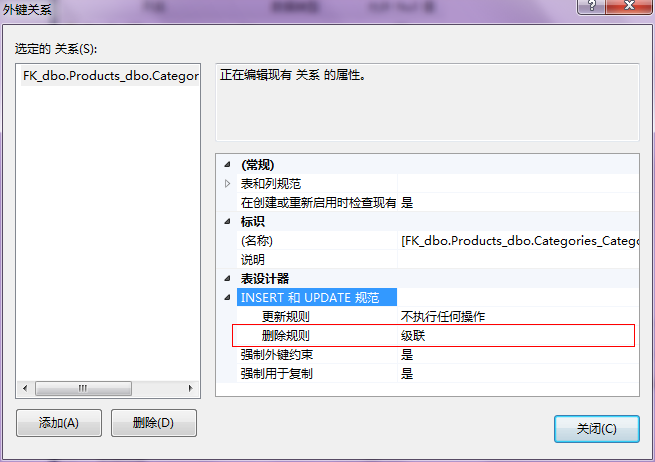
2>、[目标类型名称]+[目标类型键名称]
这种方式要求在Product表中外键列名为Category类名+Category类中键名称,即在Products表中生成的外键名称为Category_CategoryID。示例:在Category类中添加ICollection<Product> Products的集合属性,而在Product类中不做任何与Category关联的代码,也不定义CategoryID属性。
文件Category.cs:

using System; using System.Collections.Generic; using System.Linq; using System.Text; namespace Portal.Entities { public class Category { public int CategoryID { get; set; } public string CategoryName { get; set; } public virtual ICollection<Product> Products { get; set; } } }
文件Product.cs:

using System; using System.Collections.Generic; using System.Linq; using System.Text; namespace Portal.Entities { public class Product { public int ProductID { get; set; } public string ProductName { get; set; } public decimal UnitPrice { get; set; } } }
在定义以上两个类之后,不再添加任何的Entity Framework Code First与数据库的映射配置,运行之后,生成的数据表结构为:
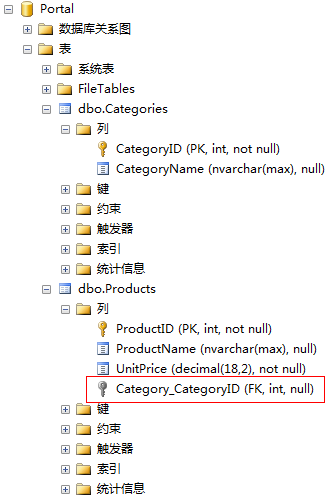
3>、[引用属性名称]+[目标类型键名称]
这种方式为要求在Product表中外键列名为在Product类中引用Category的属性名称 + Category类的主键名称。如:在Product类中定义一个Category属性Cat,则生成的外键名称为Cat_CategoryID。
文件Category.cs:

using System; using System.Collections.Generic; using System.Linq; using System.Text; namespace Portal.Entities { public class Category { public int CategoryID { get; set; } public string CategoryName { get; set; } } }
文件Product.cs:

using System; using System.Collections.Generic; using System.Linq; using System.Text; namespace Portal.Entities { public class Product { public int ProductID { get; set; } public string ProductName { get; set; } public decimal UnitPrice { get; set; } /// <summary> /// 这里为演示,使用Cat作为Category的缩写。 /// </summary> public virtual Category Cat { get; set; } } }
在定义以上两个类之后,不再添加任何的Entity Framework Code First与数据库的映射配置,运行之后,生成的数据表结构为:
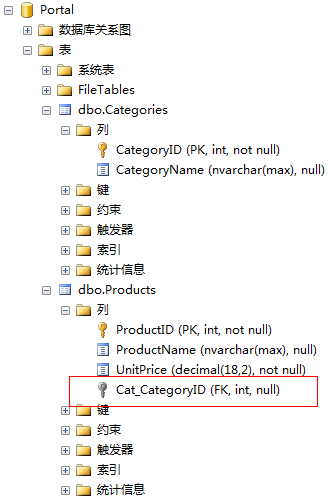
关于3种不同的外键名称命名之间存在优先级:[目标类型的键名] > [引用属性名称]+[目标类型键名称] > [目标类型名称]+[目标类型键名称]的测试方法:
[目标类型的键名]的最高优先级:只要在Product类中定义了CategoryID的属性,在Products表中生成的外键列名都只会为CategoryID。
[引用属性名称]+[目标类型键名称] > [目标类型名称]+[目标类型键名称]:只要在Product类中定义Cat属性,不管Category类中是否定义Products属性,生成的Products表中外键都只会是Cat_CategoryID。
2、一对多关系
Entity Framework Code First在根据定义的类生成数据表时,数据表之间的外键关系及所生成的外键列名有默认的约定。但这种约定同样可以进行修改,如将不满足默认外键约定的属性来作为生成表的外键。示例:Category类与Product类,在Product类中定义一个属性CatID,要将CatID属性作为Product的引用Category的外键,而按照Entity Framework Code First的默认约定是不会的。要做到需要的CatID作为外键,同样可以使用Data Annotations和Fluent API两种方式实现。
1>、Data Annotations方式
文件类Category.cs:

using System; using System.Collections.Generic; using System.Linq; using System.Text; namespace Portal.Entities { public class Category { public int CategoryID { get; set; } public string CategoryName { get; set; } public virtual ICollection<Product> Products { get; set; } } }
文件类Product.cs:

using System; using System.Collections.Generic; using System.Linq; using System.Text; using System.ComponentModel.DataAnnotations.Schema; namespace Portal.Entities { public class Product { public int ProductID { get; set; } public string ProductName { get; set; } public decimal UnitPrice { get; set; } public int CatID { get; set; } [ForeignKey("CatID")] public virtual Category Category { get; set; } } }
在定义以上两个类之后,不再添加任何的Entity Framework Code First与数据库的映射配置,运行之后,生成的数据表结构为:

查看Products表的外键咧CatID引用关系:

其中,在Product类中,为设置CatID属性为外键的代码为:
public int CatID { get; set; } [ForeignKey("CatID")] public virtual Category Category { get; set; }
该段实现方式还可以改为:
[ForeignKey("Category")] public int CatID { get; set; } public virtual Category Category { get; set; }
2>、Fluent API方式
文件类Category.cs:

using System; using System.Collections.Generic; using System.Linq; using System.Text; namespace Portal.Entities { public class Category { public int CategoryID { get; set; } public string CategoryName { get; set; } public virtual ICollection<Product> Products { get; set; } } }
文件类Product.cs:

using System; using System.Collections.Generic; using System.Linq; using System.Text; namespace Portal.Entities { public class Product { public int ProductID { get; set; } public string ProductName { get; set; } public decimal UnitPrice { get; set; } public int CatID { get; set; } public virtual Category Category { get; set; } } }
文件类PortalContext.cs:

using System; using System.Collections.Generic; using System.Linq; using System.Text; using System.Data.Entity; using Portal.Entities; namespace Portal { public class PortalContext : DbContext { static PortalContext() { Database.SetInitializer(new DropCreateDatabaseIfModelChanges<PortalContext>()); } public DbSet<Category> Categories { get; set; } public DbSet<Product> Products { get; set; } protected override void OnModelCreating(DbModelBuilder modelBuilder) { modelBuilder.Entity<Category>() .HasMany(t => t.Products) .WithRequired(t => t.Category) .HasForeignKey(d => d.CatID); modelBuilder.Entity<Product>() .HasRequired(t => t.Category) .WithMany(t => t.Products) .HasForeignKey(d => d.CatID); } } }
说明:在PortalContext.cs的OnModelCreating方法中,对两个实体类Category及Product均添加了Fluent API形式的关系配置。对于Entity Framework Code First而言,两个实体类之间的关系,可以两个类中均添加关系映射配置,也可以只对其中任意一个实体类添加关系映射配置。即在PortalContext.cs的OnModelCreating方法中可以只包含Category或只包含Product类的关系映射配置。这里从Entity Framework Code First的使用经验及技巧,建议将实体类之间关系映射配置在包含外键的类中。即OnModelCreating中只添加对Product实体类的关系映射配置,这样做有一个好处,当Category有多个表引用它时,可以将外键均配置在引用它的实体类中,从而降低Category类的复杂度,同时也有益于代码的维护。
即在PortalContext.cs的OnModelCreating方法只需下面的定义即可:
protected override void OnModelCreating(DbModelBuilder modelBuilder) { modelBuilder.Entity<Product>() .HasRequired(t => t.Category) .WithMany(t => t.Products) .HasForeignKey(d => d.CatID); }
Entity Framework Code First根据一对多关系关系生成的外键引用约束默认是有级联删除的,可以通过以下方式禁用Category与Product之间的级联删除。
protected override void OnModelCreating(DbModelBuilder modelBuilder) { modelBuilder.Entity<Product>() .HasRequired(t => t.Category) .WithMany(t => t.Products) .HasForeignKey(d => d.CatID) .WillCascadeOnDelete(false); }
也可以在Entity Framework Code First生成的全部表中都统一设置禁用一对多级联删除。
protected override void OnModelCreating(DbModelBuilder modelBuilder) { modelBuilder.Conventions.Remove<OneToManyCascadeDeleteConvention>(); }
虽然Entity Framework Code First是可以支持外键列名自定义的,但在实际的项目中,更多的外键列名称还是与所引用表的主键列名相同。即在Category表中主键为CategoryID,在Product表中外键列名称还是为CategoryID。
Entity Framework Code First的Fluent API配置实体类与表的映射关系,还可以将所有的实体类与表的映射全部写在一个类中,这样可以方便代码的维护。
文件类Category.cs:

using System; using System.Collections.Generic; using System.Linq; using System.Text; namespace Portal.Entities { public partial class Category { public Category() { this.Products = new List<Product>(); } public int CategoryID { get; set; } public string CategoryName { get; set; } public virtual ICollection<Product> Products { get; set; } } }
文件类CategoryMap.cs,用于描述Category类与生成的表之间的映射关系:

using System; using System.Collections.Generic; using System.Linq; using System.Text; using System.ComponentModel.DataAnnotations.Schema; using System.Data.Entity.ModelConfiguration; using Portal.Entities; namespace Portal.Mapping { public class CategoryMap : EntityTypeConfiguration<Category> { public CategoryMap() { // Primary Key this.HasKey(t => t.CategoryID); // Properties this.Property(t => t.CategoryName) .IsRequired() .HasMaxLength(50); // Table & Column Mappings this.ToTable("Category"); this.Property(t => t.CategoryID).HasColumnName("CategoryID"); this.Property(t => t.CategoryName).HasColumnName("CategoryName"); } } }
文件类Product.cs:

using System; using System.Collections.Generic; namespace Portal.Entities { public partial class Product { public int ProductID { get; set; } public int CategoryID { get; set; } public string ProductName { get; set; } public Nullable<decimal> UnitPrice { get; set; } public Nullable<int> Quantity { get; set; } public virtual Category Category { get; set; } } }
文件类ProductMap.cs,用于描述Product类与生成的表之间的映射关系:

using System; using System.Collections.Generic; using System.Linq; using System.Text; using System.ComponentModel.DataAnnotations.Schema; using System.Data.Entity.ModelConfiguration; using Portal.Entities; namespace Portal.Mapping { public class ProductMap : EntityTypeConfiguration<Product> { public ProductMap() { // Primary Key this.HasKey(t => t.ProductID); // Properties this.Property(t => t.ProductName) .IsRequired() .HasMaxLength(100); // Table & Column Mappings this.ToTable("Product"); this.Property(t => t.ProductID).HasColumnName("ProductID"); this.Property(t => t.CategoryID).HasColumnName("CategoryID"); this.Property(t => t.ProductName).HasColumnName("ProductName"); this.Property(t => t.UnitPrice).HasColumnName("UnitPrice"); this.Property(t => t.Quantity).HasColumnName("Quantity"); // Relationships this.HasRequired(t => t.Category) .WithMany(t => t.Products) .HasForeignKey(d => d.CategoryID); } } }
PortalContext.cs的OnModelCreating方法:

protected override void OnModelCreating(DbModelBuilder modelBuilder) { modelBuilder.Configurations.Add(new CategoryMap()); modelBuilder.Configurations.Add(new ProductMap()); }
3、一对一关系
在一对一关系中,两个表均有各自的主键,但要看哪个表的主键同时作为外键引用另一个表的主键。示例以User类与UserProfile类作为两个具有一对一关系的类,其中User类包含作为主键的UserID属性,UserProfile类包含作为主键的ProfileID的属性。
1>、Data Annotations方式
文件类User.cs:

using System; using System.Collections.Generic; using System.ComponentModel.DataAnnotations; using System.ComponentModel.DataAnnotations.Schema; namespace Portal.Entities { public partial class User { [Key] public int UserID { get; set; } public string UserName { get; set; } public string Password { get; set; } public Nullable<bool> IsValid { get; set; } public virtual UserProfile UserProfile { get; set; } } }
文件类UserProfile.cs:

using System; using System.Collections.Generic; using System.ComponentModel.DataAnnotations; using System.ComponentModel.DataAnnotations.Schema; namespace Portal.Entities { public partial class UserProfile { [Key] [ForeignKey("User")] public int ProfileID { get; set; } public string Name { get; set; } public Nullable<bool> Sex { get; set; } public Nullable<DateTime> Birthday { get; set; } public string Email { get; set; } public string Telephone { get; set; } public string Mobilephone { get; set; } public string Address { get; set; } public Nullable<DateTime> CreateDate { get; set; } public virtual User User { get; set; } } }
在定义以上两个类之后,不再添加任何的Entity Framework Code First与数据库的映射配置,运行之后,生成的数据表结构为:

在生成的数据表中,UserProfile表中的主键ProfileID同时也作为外键引用User表中的主键UserID。
修改文件类User.cs:

using System; using System.Collections.Generic; using System.ComponentModel.DataAnnotations; using System.ComponentModel.DataAnnotations.Schema; namespace Portal.Entities { public partial class User { [Key] [ForeignKey("UserProfile")] public int UserID { get; set; } public string UserName { get; set; } public string Password { get; set; } public Nullable<bool> IsValid { get; set; } public virtual UserProfile UserProfile { get; set; } } }
修改文件类UserProfile.cs:

using System; using System.Collections.Generic; using System.ComponentModel.DataAnnotations; using System.ComponentModel.DataAnnotations.Schema; namespace Portal.Entities { public partial class UserProfile { [Key] public int ProfileID { get; set; } public string Name { get; set; } public Nullable<bool> Sex { get; set; } public Nullable<DateTime> Birthday { get; set; } public string Email { get; set; } public string Telephone { get; set; } public string Mobilephone { get; set; } public string Address { get; set; } public Nullable<DateTime> CreateDate { get; set; } public virtual User User { get; set; } } }
则实体类执行之后生成的数据表User主键UserID将同时作为外键引用UserProfile表的主键ProfileID。
2>、Fluent API方式
Fluent API设置实体类生成的表引用与被引用通过WithRequiredPrincipal、WithRequiredDependent及WithOptionalPrincipal、WithOptionalDependent来设置,使用Principal属性的实体类将被另外的实体类生成的表引用,使用Dependent属性的实体类将引用另外的实体类。
文件类User.cs:

using System; using System.Collections.Generic; using System.ComponentModel.DataAnnotations; using System.ComponentModel.DataAnnotations.Schema; namespace Portal.Entities { public partial class User { public int UserID { get; set; } public string UserName { get; set; } public string Password { get; set; } public Nullable<bool> IsValid { get; set; } public virtual UserProfile UserProfile { get; set; } } }
映射文件类UserMap.cs:

using System; using System.Collections.Generic; using System.Linq; using System.Text; using System.ComponentModel.DataAnnotations.Schema; using System.Data.Entity.ModelConfiguration; using Portal.Entities; namespace Portal.Mapping { public class UserMap : EntityTypeConfiguration<User> { public UserMap() { // Primary Key this.HasKey(t => t.UserID); // Properties this.Property(t => t.UserName) .HasMaxLength(50); this.Property(t => t.Password) .HasMaxLength(100); // Table & Column Mappings this.ToTable("User"); this.Property(t => t.UserID).HasColumnName("UserID"); this.Property(t => t.UserName).HasColumnName("UserName"); this.Property(t => t.Password).HasColumnName("Password"); this.Property(t => t.IsValid).HasColumnName("IsValid"); } } }
文件类UserProfile.cs:

using System; using System.Collections.Generic; namespace Portal.Entities { public partial class UserProfile { public int UserID { get; set; } public string Name { get; set; } public Nullable<bool> Sex { get; set; } public Nullable<DateTime> Birthday { get; set; } public string Email { get; set; } public string Telephone { get; set; } public string Mobilephone { get; set; } public string Address { get; set; } public Nullable<DateTime> CreateDate { get; set; } public virtual User User { get; set; } } }
映射文件类UserProfileMap.cs:

using System; using System.Collections.Generic; using System.Linq; using System.Text; using System.ComponentModel.DataAnnotations.Schema; using System.Data.Entity.ModelConfiguration; using Portal.Entities; namespace Portal.Mapping { public class UserProfileMap : EntityTypeConfiguration<UserProfile> { public UserProfileMap() { // Primary Key this.HasKey(t => t.UserID); // Properties this.Property(t => t.UserID) .HasDatabaseGeneratedOption(DatabaseGeneratedOption.None); this.Property(t => t.Name) .IsRequired() .HasMaxLength(50); this.Property(t => t.Email) .IsRequired() .HasMaxLength(100); this.Property(t => t.Telephone) .HasMaxLength(50); this.Property(t => t.Mobilephone) .HasMaxLength(20); this.Property(t => t.Address) .HasMaxLength(200); // Table & Column Mappings this.ToTable("UserProfile"); this.Property(t => t.UserID).HasColumnName("UserID"); this.Property(t => t.Name).HasColumnName("Name"); this.Property(t => t.Sex).HasColumnName("Sex"); this.Property(t => t.Birthday).HasColumnName("Birthday"); this.Property(t => t.Email).HasColumnName("Email"); this.Property(t => t.Telephone).HasColumnName("Telephone"); this.Property(t => t.Mobilephone).HasColumnName("Mobilephone"); this.Property(t => t.Address).HasColumnName("Address"); this.Property(t => t.CreateDate).HasColumnName("CreateDate"); // Relationships this.HasRequired(t => t.User) .WithRequiredDependent(t => t.UserProfile); } } }
在以上实体类及实体映射类执行以后,生成的数据表结构如下:
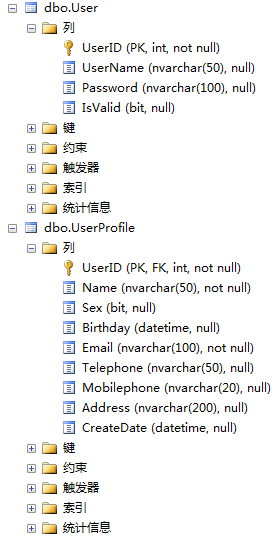
在生成的表结构中,UserProfile表中的主键UserID同时也作为外键引用User表的主键UserID。若修改UserProfileMap.cs如下,则生成的表结构User表的主键UserID将作为你外键引用UserProfile表的主键UserID。

using System; using System.Collections.Generic; using System.Linq; using System.Text; using System.ComponentModel.DataAnnotations.Schema; using System.Data.Entity.ModelConfiguration; using Portal.Entities; namespace Portal.Mapping { public class UserProfileMap : EntityTypeConfiguration<UserProfile> { public UserProfileMap() { // Primary Key this.HasKey(t => t.UserID); // Properties this.Property(t => t.UserID) .HasDatabaseGeneratedOption(DatabaseGeneratedOption.None); this.Property(t => t.Name) .IsRequired() .HasMaxLength(50); this.Property(t => t.Email) .IsRequired() .HasMaxLength(100); this.Property(t => t.Telephone) .HasMaxLength(50); this.Property(t => t.Mobilephone) .HasMaxLength(20); this.Property(t => t.Address) .HasMaxLength(200); // Table & Column Mappings this.ToTable("UserProfile"); this.Property(t => t.UserID).HasColumnName("UserID"); this.Property(t => t.Name).HasColumnName("Name"); this.Property(t => t.Sex).HasColumnName("Sex"); this.Property(t => t.Birthday).HasColumnName("Birthday"); this.Property(t => t.Email).HasColumnName("Email"); this.Property(t => t.Telephone).HasColumnName("Telephone"); this.Property(t => t.Mobilephone).HasColumnName("Mobilephone"); this.Property(t => t.Address).HasColumnName("Address"); this.Property(t => t.CreateDate).HasColumnName("CreateDate"); // Relationships this.HasRequired(t => t.User) .WithRequiredPrincipal(t => t.UserProfile); } } }
4、多对多关系
Entity Framework Code First在根据定义的多对多关系的类生成数据表时,除了生成实体类定义的属性表之外,还会生成一个中间表。用于体现两个实体表之间的多对多的关系。示例实体类User与Role为多对多关系,一个用户可以属于多个角色,一个角色可以包含多个用户。
文件类User.cs:

using System; using System.Collections.Generic; namespace Portal.Entities { public partial class User { public int UserID { get; set; } public string UserName { get; set; } public string Password { get; set; } public Nullable<bool> IsValid { get; set; } public virtual ICollection<Role> Roles { get; set; } } }
文件类Role.cs:

using System; using System.Collections.Generic; namespace Portal.Entities { public partial class Role { public Role() { this.Users = new List<User>(); } public int RoleID { get; set; } public string RoleName { get; set; } public virtual ICollection<User> Users { get; set; } } }
在定义以上两个类之后,不再添加任何的Entity Framework Code First与数据库的映射配置,运行之后,生成的数据表结构为:

从以上的表结构中,可以看出,实体类运行之后,除了生成Users表和Roles表之外,还生成了RoleUsers表作为中介表,体现Users表和Roles表之间的多对多关联关系。中介表RoleUsers的字段生成规则按照 [目标类型名称]+[目标类型键名称] 的约定。
Entity Framework Code First根据默认约定生成的多对多关联关系的表时,默认启用多对多的数据级联删除,可以添加代码进行禁用。
protected override void OnModelCreating(DbModelBuilder modelBuilder) { // 禁用多对多关系表的级联删除 modelBuilder.Conventions.Remove<ManyToManyCascadeDeleteConvention>(); }
FluentAPI实现方式:
文件类User.cs:

using System; using System.Collections.Generic; namespace Portal.Entities { public partial class User { public int UserID { get; set; } public string UserName { get; set; } public string Password { get; set; } public Nullable<bool> IsValid { get; set; } public virtual ICollection<Role> Roles { get; set; } } }
映射文件类UserMap.cs:

using System.ComponentModel.DataAnnotations.Schema; using System.Data.Entity.ModelConfiguration; using Portal.Entities; namespace Portal.Mapping { public class UserMap : EntityTypeConfiguration<User> { public UserMap() { // Primary Key this.HasKey(t => t.UserID); // Properties this.Property(t => t.UserName) .HasMaxLength(50); this.Property(t => t.Password) .HasMaxLength(100); // Table & Column Mappings this.ToTable("User"); this.Property(t => t.UserID).HasColumnName("UserID"); this.Property(t => t.UserName).HasColumnName("UserName"); this.Property(t => t.Password).HasColumnName("Password"); this.Property(t => t.IsValid).HasColumnName("IsValid"); } } }
文件类Role.cs:

using System; using System.Collections.Generic; namespace Portal.Entities { public partial class Role { public int RoleID { get; set; } public string RoleName { get; set; } public virtual ICollection<User> Users { get; set; } } }
映射文件类RoleMap.cs:

using System.ComponentModel.DataAnnotations.Schema; using System.Data.Entity.ModelConfiguration; using Portal.Entities; namespace Portal.Mapping { public class RoleMap : EntityTypeConfiguration<Role> { public RoleMap() { // Primary Key this.HasKey(t => t.RoleID); // Properties this.Property(t => t.RoleName) .HasMaxLength(50); // Table & Column Mappings this.ToTable("Role"); this.Property(t => t.RoleID).HasColumnName("RoleID"); this.Property(t => t.RoleName).HasColumnName("RoleName"); // Relationships this.HasMany(t => t.Users) .WithMany(t => t.Roles) .Map(m => { m.ToTable("UserRole"); m.MapLeftKey("RoleID"); m.MapRightKey("UserID"); }); } } }
运行之后生成的表结构:
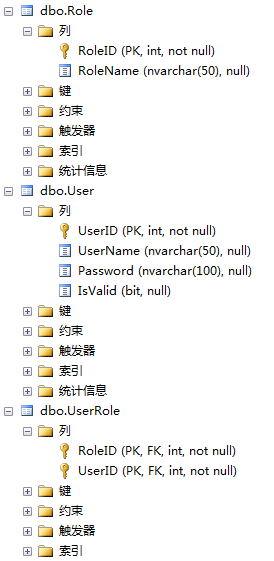
5、一对多自反关系
一对多自反关系,即一个表存在一个外键列引用自身的主键。在项目中,最常见的一对多自反关系为分类表,分类表通过一个ParentID列保存引用主键,已实现无限级递归。
Fluent API实现方式:
文件类Category.cs:

using System; using System.Collections.Generic; namespace Portal.Entities { public class Category { public int CategoryID { get; set; } public int CategoryNo { get; set; } public string CategoryName { get; set; } public Nullable<int> ParentID { get; set; } public virtual Category Parent { get; set; } public virtual ICollection<Category> Children { get; set; } } }
映射文件类CategoryMap.cs:

using System.ComponentModel.DataAnnotations.Schema; using System.Data.Entity.ModelConfiguration; using Portal.Entities; namespace Portal.Mapping { public class CategoryMap : EntityTypeConfiguration<Category> { public CategoryMap() { // Primary Key this.HasKey(t => t.CategoryID); // Properties this.Property(t => t.CategoryName) .IsRequired() .HasMaxLength(50); // Table & Column Mappings this.ToTable("Category"); this.Property(t => t.CategoryID).HasColumnName("CategoryID"); this.Property(t => t.CategoryNo).HasColumnName("CategoryNo"); this.Property(t => t.CategoryName).HasColumnName("CategoryName"); this.Property(t => t.ParentID).HasColumnName("ParentID"); // Relationships this.HasOptional(t => t.Parent) .WithMany(t => t.Children) .HasForeignKey(d => d.ParentID); } } }
以上代码在运行之后,生成的数据表:
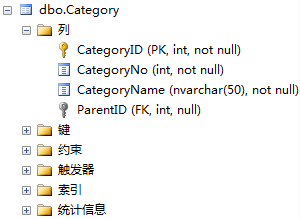
6、多对多自反关系
多对多关系示例:Family中一条记录可能有多个Parents,也可能有多个Children。
文件类Family.cs:

using System; using System.Collections.Generic; namespace Portal.Entities { /// <summary> /// Family表多对多自反关系 /// </summary> public partial class Family { public Family() { this.Parents = new List<Family>(); this.Children = new List<Family>(); } public int FamilyID { get; set; } public string Name { get; set; } public Nullable<bool> Sex { get; set; } public Nullable<System.DateTime> Birthday { get; set; } public virtual ICollection<Family> Parents { get; set; } public virtual ICollection<Family> Children { get; set; } } }
映射文件类FamilyMap.cs:

using System.ComponentModel.DataAnnotations.Schema; using System.Data.Entity.ModelConfiguration; using Portal.Entities; namespace Portal.Mapping { public class FamilyMap : EntityTypeConfiguration<Family> { public FamilyMap() { // Primary Key this.HasKey(t => t.FamilyID); // Properties this.Property(t => t.Name) .HasMaxLength(50); // Table & Column Mappings this.ToTable("Family"); this.Property(t => t.FamilyID).HasColumnName("FamilyID"); this.Property(t => t.Name).HasColumnName("Name"); this.Property(t => t.Sex).HasColumnName("Sex"); this.Property(t => t.Birthday).HasColumnName("Birthday"); // Relationships this.HasMany(t => t.Parents) .WithMany(t => t.Children) .Map(m => { m.ToTable("FamilyRelationship"); m.MapLeftKey("ParentID"); m.MapRightKey("ChildID"); }); } } }
Family类及映射配置类,在运行之后生成的数据表结构:
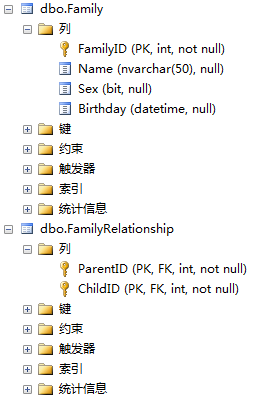
在上面的表结构中,指定Family之间的中介表为FamilyRelationship,其中FamilyRelationship的两个字段ParentID及ChildID均引用Familyi表中的FamilyID作为外键。可能在实际的项目过程中,出现这种多对多自反引用关系的情况比较少见。


